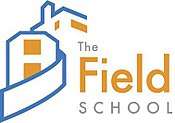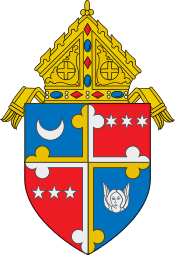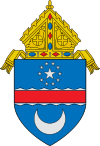The Field School
The Field School is a preparatory school in Washington, D.C., located in the old Cafritz mansion on Foxhall Road. The school teaches 6th-12th grade, with about 380 students attending.
| The Field School | |
|---|---|
 | |
| Location | |
United States | |
| Information | |
| Type | Independent School |
| Motto | Aude Sapere |
| Head of school | Anne Foley |
| Enrollment | 380 (grades 6-12) class sizes = 11 |
| Student to teacher ratio | 6:1 |
| Campus | 10.5 overall acres 4 buildings |
| Color(s) | Blue and Gold |
| Athletics conference | Potomac Valley Athletics Conference (PVAC) |
| Mascot | Falcon |
| Tuition | $47,780 |
| Website | fieldschool.org |
History
The Field School was founded in 1972 by Elizabeth Ely (1924–2009). Originally housed above Regina Cleaners in the Washington, D.C.'s Dupont Circle neighborhood, the school had 44 students. Two years later, in 1974, the school's student population had more than doubled to 97, which the school's small location could not accommodate. Field found a new home, an old house nearby, but movers were not in the budget. That spring, students, faculty, and parents carried the school's belongings, including the furniture, up the street to the new location.
Field continued to grow at its new location. Field bought another house across the street, and the two houses were used for the now 220 of Field's students. In 1993, Field was accredited by the Middle States Association of Colleges and Schools. This accreditation came with publicity and credibility for the school, but also the requirement of a new campus, according to the Association. The school began frantically raising money, and in 1998, discovered the Cafritz mansion and the 10.5 acres (42,000 m2) of land that accompanied it. The mansion and its land was purchased for $10 million by the school.
Field began construction on the new campus and began using it in 2002. The new campus included a gymnasium and playing field, firsts for Field, as well as new science labs and dedicated studio spaces for art, photography, ceramics, and, later, music. In 2004, Dale Johnson was appointed to the position of Head of School, and in 2006 Elizabeth Ely retired. In 2007, a three-year strategic plan was created by school leadership with assistance from the community as a whole.
In late 2007, the school's new logo was released. The logo depicts the facade of a part of the original Cafritz mansion.
At the end of the 2009-2010 school year, the Field School renovated large portions of the Cafritz mansion.
In 2011, it was announced that the Field School will be adding a sixth grade to its middle school in 2012.
Campus
The Field School is located on the grounds of the Cafritz mansion. The campus has four buildings:
- The Aude building, named for the first word of the school's motto, which contains the admissions office and other administrative offices as well as faculty offices, classrooms, an art room, the school psychologist's office, and a publications lab.
- The Cafritz building, the original mansion of the Morris and Gwendolyn Cafritz. This building contains administrative and faculty offices, classrooms, the school's library and media center, and gathering spaces, including the original Cafritz living room and the middle school lounge. The signed Steinway piano is kept tuned in the living room.
- The Sapere building, named for the second word of the school's motto. This building contains faculty offices, classrooms, and science labs, as well as a 400-seat blackbox theater, gym, and batting cage.
- The Wonder building, named after the school's original campus. It is home to locker rooms, a photography lab and darkroom, a ceramics studio, and a dance and yoga studio.
- The Elizabeth Meeting House, named after founder Elizabeth Ely. The $19 million structure was completed in the summer of 2015. The Meeting House features lockers, a music room and recording studio, general meeting spaces, the main office, a green roof and patio, and a kitchen.
- The Bridge building connects the Cafritz and Sapere buildings and consists of three rooms, two class rooms and an art room. It was completed along with the Elizabeth Meeting House in the summer of 2015.
Gallery
 The Cafritz House
The Cafritz House The Aude Building
The Aude Building The Sapere Building
The Sapere Building The Living Room
The Living Room
Special programs
Winter Internship
Every February all students at Field take two weeks to pursue an internship in any field they choose. Some Field students take school-sponsored trips to Peru, Spain, France, and other countries or participate in the pre-professional internship theater show. Some of the organizations Field students have worked for include: Bethesda Cares, D.C. Superior Court, Embassy of Sweden, Fleet Feet, Food and Friends, The Motley Fool, National Geographic, National Museum of Natural History, National Oceanic and Atmospheric Administration, Sibley Memorial Hospital, The Washington Post, WAMU 88.5 Radio, the U.S. House of Representatives, the U.S Senate, and the World Bank.
Honors seminar
Offered during the after-lunch activity period, these extra-small seminar classes meet once each week. They provide students with the chance to study a subject beyond the traditional Field curriculum. Teachers (and sometimes teachers with students) choose a subject of particular interest to them or a subject with which they have particular expertise, then design a class that emphasizes discussion. Previous Honors courses include: The History of Hip-Hop, LOST and Philosophy, Urban Planning, A Study of The Kennedy Assassination, and The History of Pirates.
Honor Council
The Field School employs a unique system for handling matters of academic dishonesty that differ from other area private schools. When a student plagiarizes, cheats, or in any ways infringes on the honor code, an Honor Council of students is held, which help determine the actions that need to be taken in each case of academic dishonesty.
Sports
Field offers cross-country, soccer, tennis, basketball, yoga, indoor and outdoor track, baseball, softball, Ultimate Frisbee, girls' volleyball, and girls' lacrosse. Various physical education courses are offered each year as well. The school employs a no-cut policy, allowing all students to participate in the sport of their choice.
Notable alumni
- Zach Cregger (class of 1998)
- Rachel Grady (class of 1990)
- Joshua Harris (class of 1982), billionaire private equity investor, co-founder of Apollo Global Management, and principal owner of the New Jersey Devils of the NHL and the Philadelphia 76ers of the NBA
- Jennifer Herrema
- Courtney Hunt (class of 1982)
- Spike Jonze, photographer, filmmaker, director and actor known for co-creating MTV's Jackass franchise, as well as directing Where the Wild Things Are (2009) and Her (2013)
- Dan Joseph (class of 1997) WBAL Baltimore, radio talk show host
- Justin Theroux, screenwriter, director, actor and film producer known for his appearances in Charlie's Angels: Full Throttle (2003) and The Spy Who Dumped Me (2018), as well as for his screenwriting work for films such as Tropic Thunder (2008) and Iron Man 2 (2010). He was also married to actress Jennifer Aniston from 2015 to 2017.
- Craig Wedren
See also
- Sapere Aude
References
| Wikimedia Commons has media related to The Field School (Washington, D.C.). |
- "A Brief History of The Field School". The Field School. Retrieved 2008-06-07.



